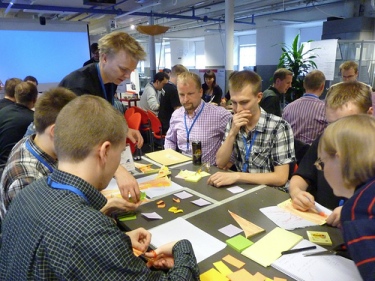看板披萨游戏(Kanban Pizza Game)- 译
 由Agile42公司开发的看板披萨游戏遵循以下许可:Creative Commons Attribution-Share Alike 3.0 License.
由Agile42公司开发的看板披萨游戏遵循以下许可:Creative Commons Attribution-Share Alike 3.0 License.
仅仅通过教科书的方式传授精益敏捷的原则,是很困难的。人们必须亲身经历这些原则以体会它们是如何工作的。通过游戏,不必打乱日程工作或沉迷在技术细节,你就可以获得经验。这也是我们在培训中使用游戏和模拟的原因。如果没有合适的游戏,我们就创造一个,比如看板披萨游戏!
通过agile42公司的这个游戏,你可以发现看板是什么。然而其他看板游戏通常关注白板概念和已有看板系统中的工作流,我们的看板披萨游戏教会大家如何从现有流程产生看板系统。
用纸做披萨
如agile42 Scrum Lego City Game,我们希望看板游戏用每个人都熟悉的东西并且每个人都能做。我们尝试远离IT环境,因此参与者不用考虑太多和他们现有工作环境的相似处。我们认为用纸做披萨这个想法太棒了——每个人都喜欢披萨,并且每人都知道披萨是怎么做的。(至少知道一般术语)
什么时候以及如何使用看板披萨游戏
如果你想要理解看板是什么,以及在日常工作之外的安全环境里实践一些精益概念,那么看板披萨游戏是最合适的!
学习目标
从培训的角度这个游戏的目的是什么?我们希望参与者:
- 体验看板系统如何从已有的流程中浮现出来(如工作当中那样)
- 体验一个完整的看板系统(而不是只关注白板和相关概念)
- 理解白板是依赖于场景的:对于任何流程,都有许多不同设计的看板,这些都是适当和实用的,而不必只有一个最优的看板。
- 理解限制在制品(Work In Progress)的影响。
- 体验自组织和适应性。
- 充满乐趣!
每个团队都有不同颜色的纸、剪刀和其他材料(参见本页底部的完整物料清单)。团队根据配方裁剪、涂抹和粘贴这些材料以形成披萨。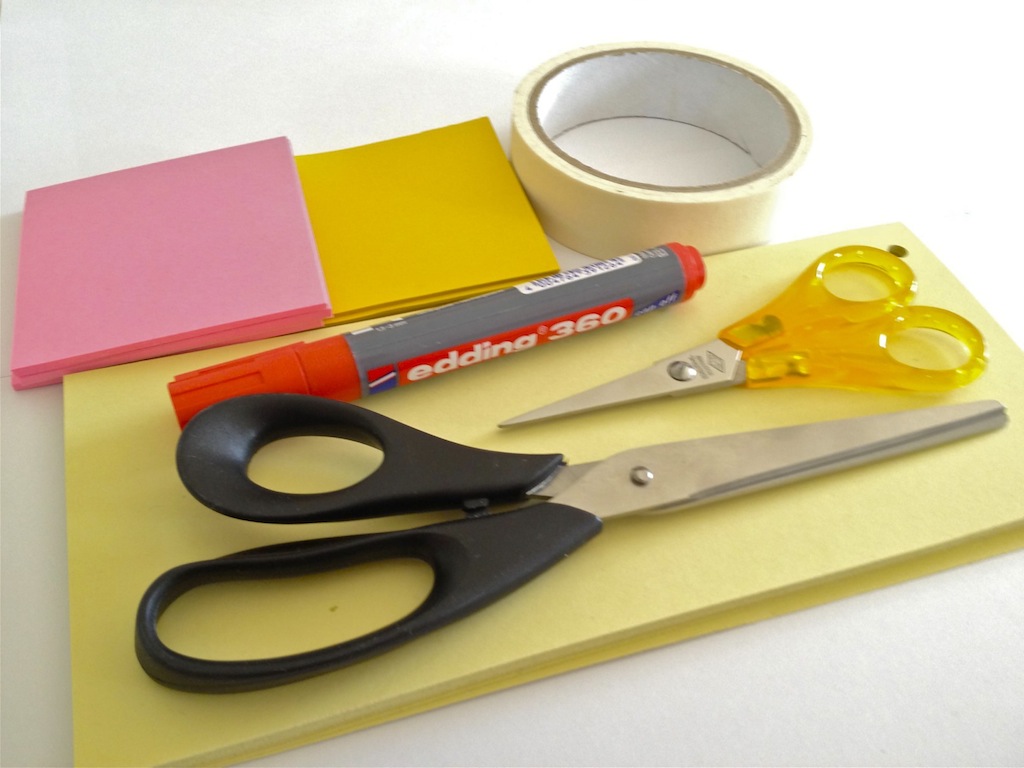
准备
- 这个游戏从开始到结束有一套PPT可以使用。(译者注:后续提供不需翻墙的链接)
- 确保充足的物料!
- 每组至少4个人
- 可以一个组玩,但多组的话会增加有益的竞争,也会更有趣
- (可选) 如果人数为奇数,可以考虑邀请他做观察员,担当质量监控并衡量交货时间。
游戏流程
1. 第一轮,创建一个隐含的流程
看板总是从你当前现有的流程开始的。在游戏的开始,让团队拿一些纸片并制作尽可能多的披萨(夏威夷)。如下图
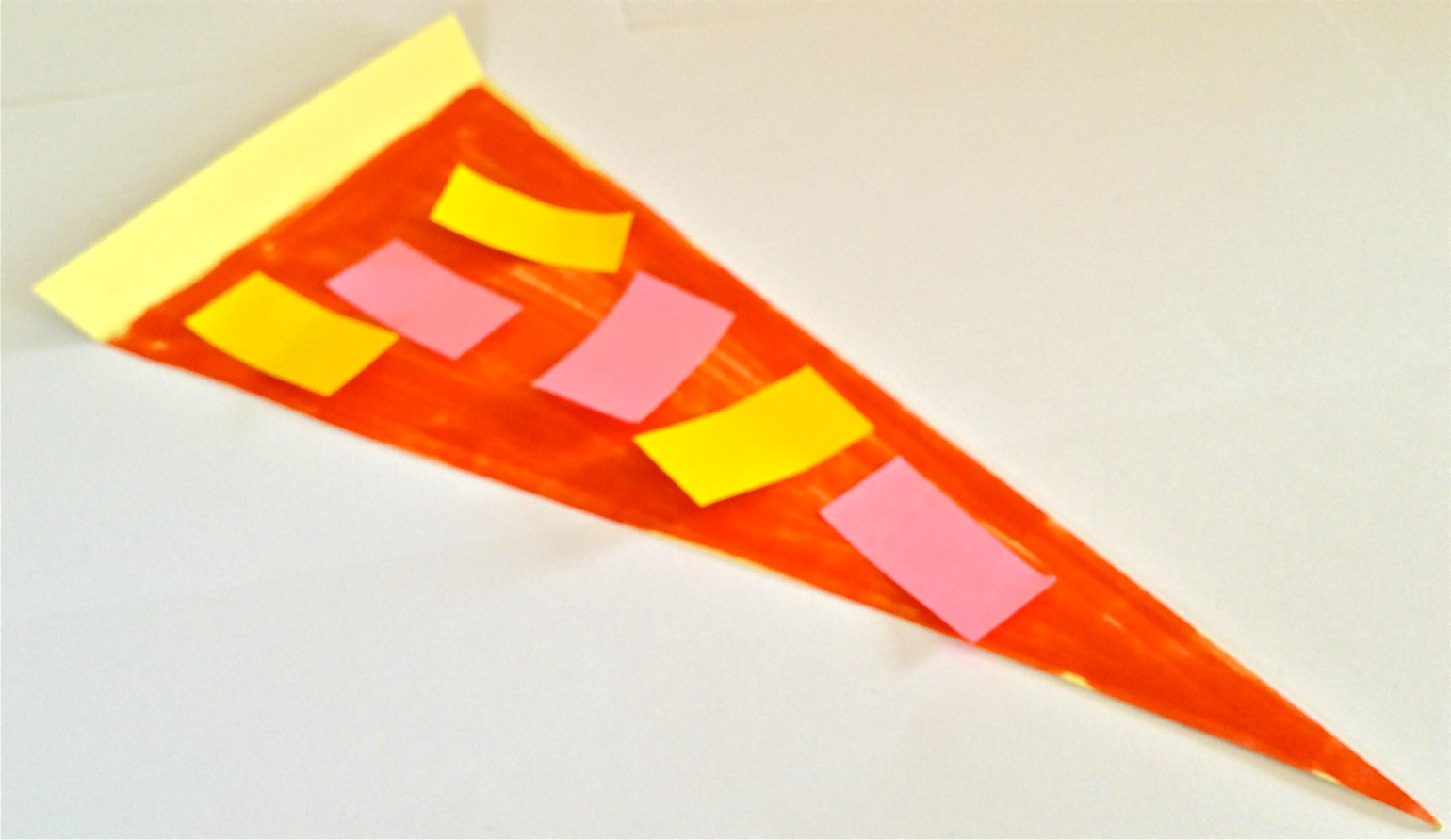 展示一块做好的夏威夷披萨并解释怎么做的:一块披萨饼底(三角形纸),番茄酱(红色马克笔),3块火腿(粉色便利贴)和3块菠萝(黄色便利贴)。番茄酱要涂满饼底(译者注:记得披萨饼有卷边哦),馅料大小合适并均匀分布在披萨上。
展示一块做好的夏威夷披萨并解释怎么做的:一块披萨饼底(三角形纸),番茄酱(红色马克笔),3块火腿(粉色便利贴)和3块菠萝(黄色便利贴)。番茄酱要涂满饼底(译者注:记得披萨饼有卷边哦),馅料大小合适并均匀分布在披萨上。
演示烤箱盘并演示怎么用。烤箱一次最多烤3块披萨。烤的时间最少30秒。在烤的过程中不能动烤箱(增加或拿走披萨)!
下面要求团队制作尽可能多的披萨,但要避免浪费,如准备好而不用的原材料。当你决定结束的时候(大概5-7分钟后,不事先确定时间),告诉大家停下来。
2. 介绍看板
在第一轮结束后,介绍看板和核心看板实践。
核心看板实践:
- 使工作流可视化
- 限制你的在制品数量(WIP)
- 管理流动(Flow)
- 实现反馈环
- 明确流程原则
- 一起改进
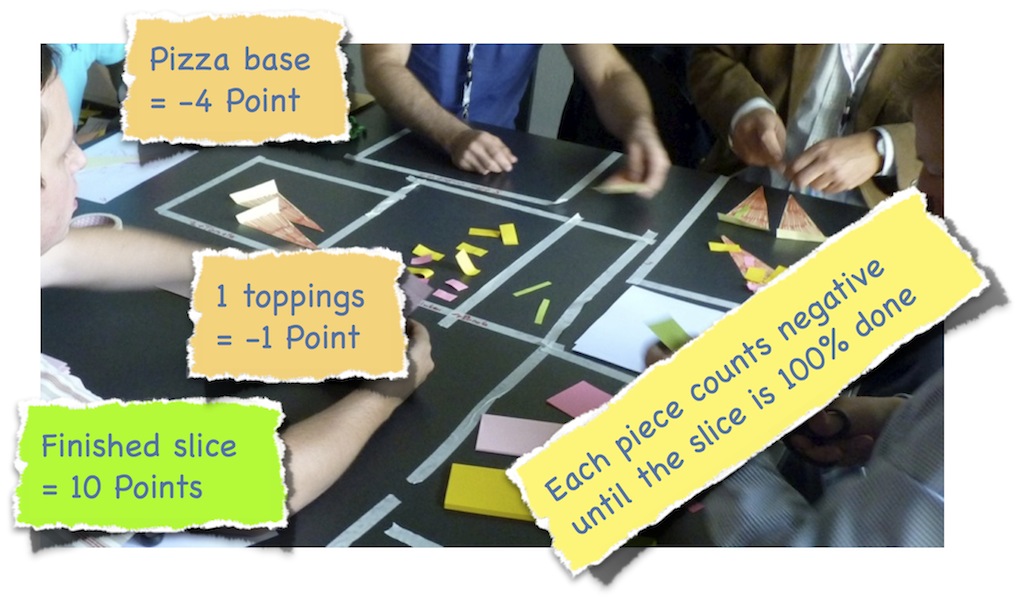 接下来,介绍计分系统并让团队自己算分。设计计分系统是为了提倡限制WIP,并且可以间接地流动(在这个游戏中,流动和交货时间是有关联的,只要人们不知道一轮的准确时长,他们就会重复相同的行为)。收集分数并记录到白板或者挂图上。
接下来,介绍计分系统并让团队自己算分。设计计分系统是为了提倡限制WIP,并且可以间接地流动(在这个游戏中,流动和交货时间是有关联的,只要人们不知道一轮的准确时长,他们就会重复相同的行为)。收集分数并记录到白板或者挂图上。
让团队把工作流可视化并且通过引入生产材料库存(披萨饼底,火腿块等)来使流程更明确。现在不要尝试优化工作流,仅仅把第一轮出现的内容记录下来。
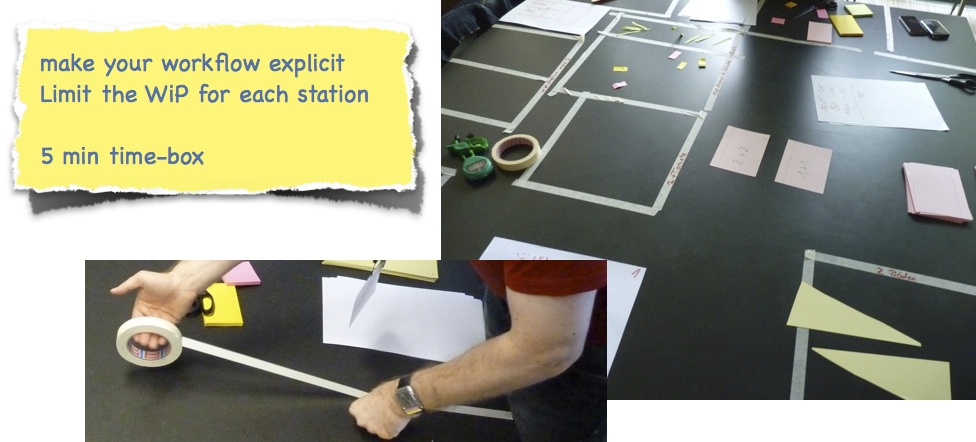 让团队限制他们的在制品(WIP)。第一轮结束后团队有一堆的材料浪费了吗?每个步骤合理的WIP大小是多少?
让团队限制他们的在制品(WIP)。第一轮结束后团队有一堆的材料浪费了吗?每个步骤合理的WIP大小是多少?
披萨的质量如何?有没有偷工减料?披萨饼底应该是一样大并且涂满番茄酱,馅料剪得很精美且分布均匀。
下轮开始之前,扔掉已经交付的披萨,但保留没有用过的材料,包括桌子上没烤过的披萨。
3. 第二轮,使用刚才建立的看板系统
现在用刚刚建好的看板系统开始下一轮。再次强调,快要结束的时候不要给出任何提示,当你觉得差不多的时候(5-7分钟后)就结束这一轮。结束后做一个小结并算分。
接着让团队花1分钟反思一下,他们的看板系统哪里挺好的,哪里需要改进,并再花1分钟重新设计工作流和尝试不同的WIP限制数目。
4. 第三轮,扩展
给游戏增加点复杂度,引入客户订单和一种新的披萨(蔬菜配方)。订单可以包含1种或2种披萨,只有整个订单完成了才能得分(订单里披萨的总分)。蔬菜披萨没有火腿和菠萝,只有7条蔬菜(绿色的便利贴)。可惜蔬菜一烤就很容易焦了,所以只能在披萨烤好后粘上。
让团队花几分钟讨论和改进他们的系统。开始,小结,计算分数。团队花1分钟反思他们的系统哪里不错,哪里需要改进,然后再花1分钟重新设计工作流和调整WIP限制数目。
5. 第四轮,也是最后一轮
开始,小结,计算分数。
6. 从游戏到一个真正的看板
游戏的最后一步是,团队在桌子上用美纹胶带把流程可视化,并创建了非常接近真实的看板系统。
让团队回顾一下游戏,在挂图或白板上画出工作流(包括WIP限制),可以把材料和做好的披萨粘在上面。如下图:
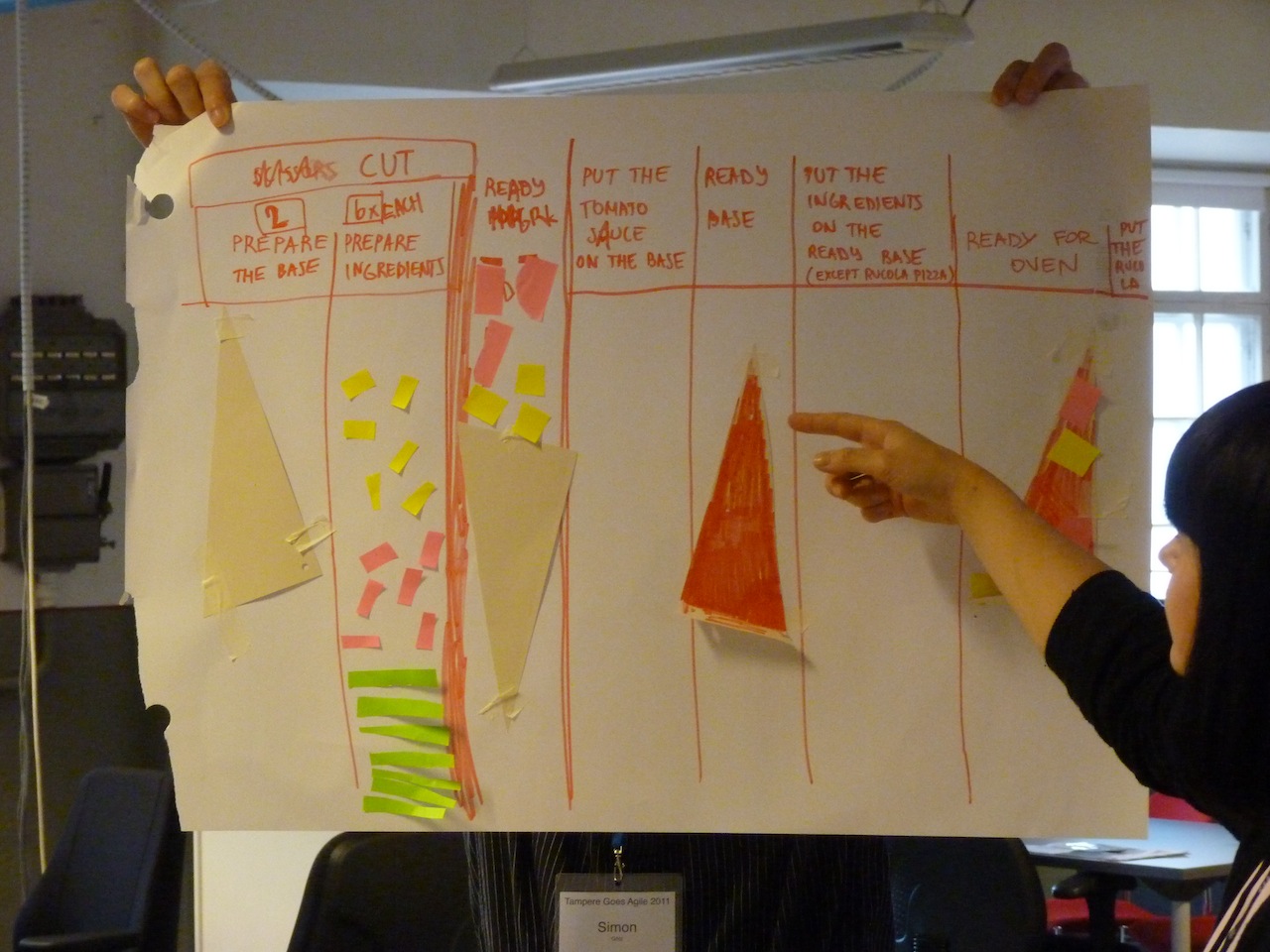
7. 总结
刚刚经历了披萨游戏和展示了一些很好的看板,联系到看板实践就会很容易了。
使工作流可视化
披萨实际生产的工作流一直存在的,通过画出工作流我们创建了一个模型,可以用来思考现有的流程。
注意工作流可以用多种方式表现。有的披萨带着馅料进烤箱而有的不可以,这个事实可以通过许多方式描述,如标签,泳道,非线性工作流,有向网络等等。通过这个游戏,每个团队在他们自己的人、资源和瓶颈的背景下创建了一个有意义的工作流。然而就像其他团队可以设计自己的看板,不是说谁的看板比其他人的更正确。(译者注:适合团队的看板系统才是最好的,不要尝试去照搬其他人的)
限制WIP
 游戏中,内建的瓶颈导致堆积的队列。这是有意设计的。团队引入限制在制品(WIP)的数量来确保做正确的事情,以及避免浪费。团队体验到WIP限制的作用:驱使和改变人们的行为。在整个生产过程中人们倾向于更多的交互,交流的更多并且需要的时候彼此互助。
游戏中,内建的瓶颈导致堆积的队列。这是有意设计的。团队引入限制在制品(WIP)的数量来确保做正确的事情,以及避免浪费。团队体验到WIP限制的作用:驱使和改变人们的行为。在整个生产过程中人们倾向于更多的交互,交流的更多并且需要的时候彼此互助。
管理工作流
当系统中的工作很好流动的时候,看板的效果最好。一般我们通过衡量和最小化交货时间来提高工作流动效率。可惜这需要引导师花费很多时间,所以在披萨游戏中我们使用计分系统,来惩罚库存并触发类似的优化工作流行为。
在第一轮游戏中,团队倾向于提前准备好一小堆材料。在接下来的几轮中,团队认识到要使库存降下来并通过缩小WIP来保持工作流动。
衡量披萨游戏中的流动也是很有启发性的,但需要一个人帮忙计时。
其他需要考虑的事情:
_物理环境:_桌子的摆放影响初始的工作流吗?工作流演进的方法?
_群里动力(Group Dynamics):_ 不同的团队成员如何参与到工作流的设计中?
物料清单
- 3种颜色便利贴:黄色(菠萝),粉色(火腿)和绿色(蔬菜)
- A4纸若干(或者其他浅颜色的纸张,方便涂抹番茄酱)
- 红色马克笔
- 胶水或胶棒(在披萨饼底上粘馅料)
- 美纹胶带
- 剪刀(每组大、小剪刀各一把)
- 计时器(可选,用手机计时)
- 订单 - 每组一套
- 烤箱盘 - 每组一个
- 看板披萨游戏的幻灯片
- 规则说明表
- 看板概述表
Questions, Answers, Tips and Tricks(暂不译)
Can we take unused raw materials and use them in the next round? Yes, you are supposed to do exactly that. The unused slices of ham, pineapple, rocket salad and pizza bottoms on the table will of course give you negative points at the end of each round.
Why can’t we have a big stopwatch and rounds of exactly six minutes? If the team knows how much time is left, they will start ramping down the process a minute ahead of time, in order to minimize waste. While minimizing waste is good, we want the teams to do it while work is still going on. In practice, something between five and seven minutes seems to be fine.
The team asks for an extra oven, should I give it to them? No. For each bottleneck you remove, it takes some time before the workflow resettles (see the Theory of Constraints) and a new bottleneck emerges. Repeat this a couple of times, and the game is over. So what was the outcome of the game? Now the team never learned to actually cope with bottlenecks by themselves. Instead they learned that they can complain about the bottleneck and have it magically removed. Oops.
The game is too slow, the teams need more pressure to get things done. All teams are different and lack of visible pressure is not necessarily bad. Let the game emerge and don’t push the teams into a fixed script. Observe what is happening and gently strengthen good behavior and suppress unwanted behavior. That said, if you feel that the teams are not doing their best, try to create a bit more competition between teams. You could also ask the teams to measure and improve the lead time.
Some teams are working too fast and making ugly pizzas. How should I approach that? Make it visible, make it explicit. Point out the quality difference to all teams and ask them to agree on the quality level. They could for example nominate a joint QA person to examine and accept pizza deliveries, or draft a Definition of Done, or make a Standard Reference Pizza.
I want to introduce more pizza recipes, can I do that? The keyword in this game is Kanban, not Pizza. The game contains two simple but slightly different workflows, introduced one at a time, and this is fully sufficient to bring out all the Kanban practices. Adding more recipes doesn’t improve the learning experience; in fact some teams already struggle with the two overlapping workflows and would not cope well with the complexity of additional pizza recipes.
Can I measure the lead time anyway? Yes, measuring and plotting the lead time can be very interesting and constructive. Please delegate this to a co-facilitator or even to the teams themselves, as the main facilitator is typically fairly busy even during the rounds.
Variations and extensions. If you develop a great extension that in your opinion works well and enhances the game, we’d be delighted to hear about it and possibly also include it in a future version. However, we’ve seen and heard of facilitators introducing things that don’t work particularly well, such as new pizza recipes, the pizza boy, the snotty customer, or a money system for buying ingredients and selling pizzas. Please remember that the Kanban Pizza Game is first and foremost a learning experience and a teaching tool. It’s not even about pizza, it’s about Kanban! Don’t let the game degenerate into mindless entertainment, a cut-throat competition or total chaos. Keep the game tight and focused on the learning objectives in your intended way.

